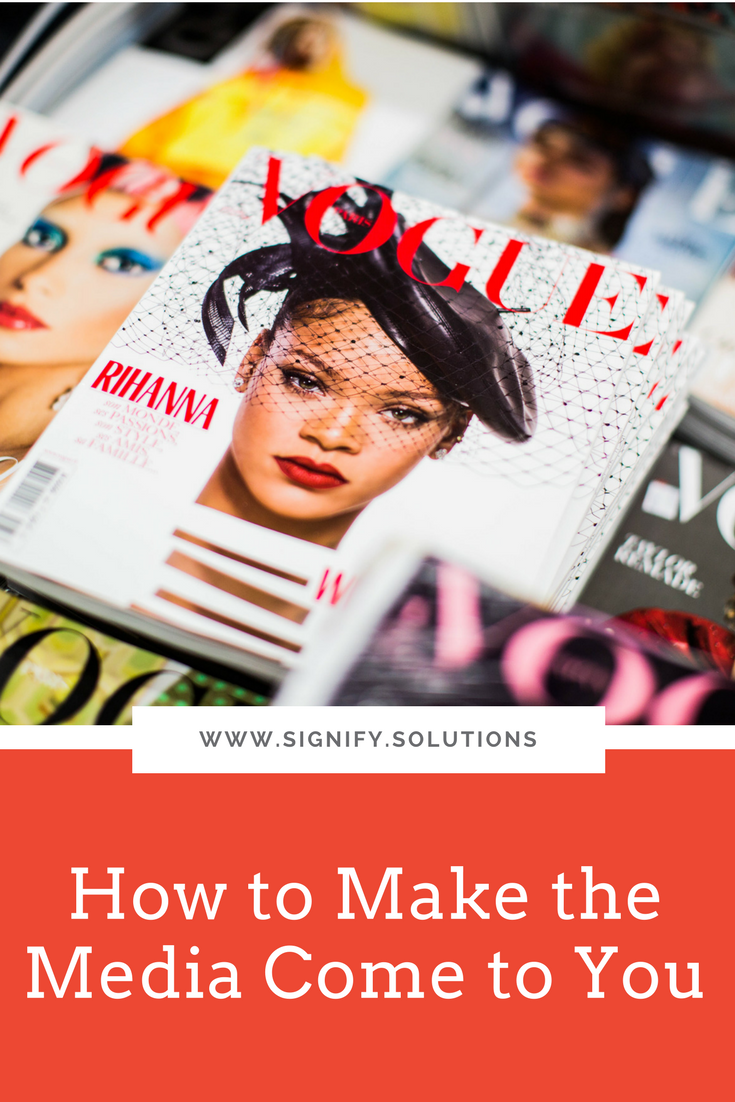If you've been wondering what makes for great business writing, you're in luck! Based on feedback from the Signifiers Facebook Group, we're focusing on writing tips all month long. But before we talk about how to write an enticing and effective blog post, website, or social media, let's first chat about common writing mistakes.
I don't know about you, but I see errors on professional websites, blogs, social media, and even national commercials almost daily. And, as someone who can spot them, it makes the brand seem more amateur to me, especially when it's a large company. That's definitely not what I want for your organization.
So, to kick things off, I asked a few of my favorite #girlboss editors to explain some common writing mistakes, which will allow you to spot any weaknesses you may have, and improve them. (Basically, here's how you can up your writing game in just a few minutes!) Any corrections you can catch now may cause you to retain customers and donors in the future.
Audience
My biggest tip for any and all writers would be to remember your audience. If you don’t know who you’re writing to, don’t start writing until you figure that out! Identify your primary audience and then write with them in mind. Read everything back through the lens of that audience and ask yourself if it makes sense just for them. Did it communicate specifically to that audience?
As an editor, one the biggest content mistakes I find myself having to correct is a lack of focus on an audience. It’s much easier to make a clear point and deliver a direct message to one, specific audience. When a writer or brand doesn’t know who they’re trying to communicate to, clarity and messaging gets lost and mixed up pretty quickly!
Grammar, Punctuation, Spelling, and Related Nonsense
The Oxford Comma Debate
To add the third comma, or not to add the third comma. That is the question. A REAL BIG pet peeve of mine when editing is inconsistent commas. The Oxford comma is the last comma in a list of three or more items just before the "and" or "or." For example, “Johnny, April, and Samantha drove to the store to get Tombstone frozen pizza, which as we all know, is the best kind of pizza.” The comma after "April" is the Oxford comma.
The reason this matters is that sometimes the meaning of the sentence can be misconstrued without the comma. In the above example, it might otherwise seem like we’re telling Johnny that April and Samantha went to get delicious pizza without him, which is very rude. Without the Oxford comma, the last two subjects can sometimes be grouped together separately, leaving the first guy all alone, hungry, and wishing he had pizza. So, my humble opinion is to be kind and add the Oxford comma.
There are a lot of opinions on this topic, but no matter where you fall, my one piece of advice is be consistent. Whether you want to use it or not, whenever you have a list of three or more, make sure you either always or never use your Oxford comma. This will make your editor's life much easier, and it will clear up any misunderstandings in your text by your willy-nilly use of punctuation.
The number one mistake I have corrected lately (and so many times) is no comma before "and" (or any other conjunction) when marrying two sentences that could stand on their own. For example: Kristi Porter is a friend of mine. She is a talented writer. If I put those two sentences together, I have to say, "Kristi Porter is a friend of mine, and she is a talented writer."
A second thing that bothers me is the very popular use of "based off." A base is something you put something else ON. A base is a launching pad, a setting place. You can only base something ON something else.
A resource Jill recommends:
I will also add two of my own here:
First, an ampersand, or the famous "&" character, should not be placed in the middle of a sentence. I think this probably became more popular when people started writing like they text (note: me shaking my head and sighing). Use it for titles, names, and things like that, but if you're using it in a sentence because typing two more characters for "and" is a bit much for you, rethink it. It just leaves me feeling that whatever is written is unprofessional or sloppy. And it drives me insane to see large businesses who can afford proofreaders make this mistake.
Second, and somewhat related, is the use of single and double quotes. I still hold true to what I was taught in school: use double quotes every dang time, unless you are quoting someone within a set of quotes. For example: "I turned to look at a bewildered Samantha who said, 'Oh, no, she didn't!' and then we both burst out laughing."
That latter mention is the only time I believe a single quote should be used. And I really enjoyed this funny, tirade on the subject. Again, I think this leads back to texting being the death of proper writing. (Call me old, I don't care!) Then again, sometime these mistakes keep me in business, so there's that...
Resources I recommend:
I admit to Googling these questions now and again, but I only get my answers from reputable sources like AP Stylebook, Grammarly, and Grammar Girl, which you'll also see noted below.
Make friends with editors, ha! I'll also admit to texting some of these ladies questions from time-to-time.
If you have the budget, hire a proofreader. It may not seem like it should be at the top of your list, but remember, everything you say (including how you say it) conveys something about your organization. If you're asking people to buy something from you, or donate to your organization, you'd better make sure that you look and sound professional. Personally, if I see a lot of errors in a website, email, blog, or social media, that's not where I'm going to send my money.
Style
When writing, nothing is more often overlooked or more impactful than tension. Tension helps the reader answer the question, “why do I care?”. It moves them to feel something, to engage.
The problem is that no one really likes tension, not even the author. We want it to be relieved. We want the reader to know that we know the answer to the questions we’re asking. We want to stop feeling the tension, so we resolve it to quickly. And in doing so, we unknowingly sabotage ourselves.
The truth is, there’s a lot of content out there and our time is limited. So helping a reader know why this topic matters to them is key if we want them to stick around.
A resource Crystal recommends:
Communicating for Change by Andy Stanley
Don't fall into the trap of foregoing correctness for the sake of being catchy or memorable. Trust me, you'll be remembered—but not for the reasons you'd like! Creativity is great, but keep it professional by using proper spelling, grammar, and punctuation.
Playing off of words is welcomed (i.e. naming a boutique "Sew In Style"), but there's no need to get sloppy ("Sew 'N Style" or worse, "Sew-N-Style"). You'll be hurting yourself by appearing amateur. Plus, deviating from traditional spelling, punctuation, or grammar opens the door wide open for vendors, donors, and customers to misspell or confuse your brand. Naming an event, product, or campaign? You guessed it. Same rules apply in order to put your best foot forward.
Resources Leigh recommends:
Follow @APStylebook on Twitter
A Little of This, A Little of That
Effective writing is the foundation of successful messaging—in public relations and beyond. It can communicate the strengths of a brand to virtually any targeted audience, convert skeptics into evangelists, and it can make the journalist receiving it say, “Yes! I want to write a story about that!” Bad, boring, or unclear writing will make many people ignore the potentially terrific information you have to share.
What Makes Bad Writing?
Too much "puffery" such as: "It will be a fun-filled evening for the entire family, with each hilarious performance starting promptly at 8 p.m.”
Empty/meaningless language: there is, amazing, actually, basically, really, charming, fantastic, wonderful, etc. Use concrete adjectives that convey what you want to say.
Cramming in too many big words, just for the sake of, well, using big words.
Being unclear. Don’t make assumptions about your reader’s knowledge of a subject.
What Makes Good Writing?
Master the basics (grammar, structure, format) and then build in personality and “punch” from that strong foundation.
Write for clarity. Read your work with a critical eye, asking the question, “If I weren’t close to this project, would this paragraph make sense?”
Be concise, but include interesting details that entice the recipient to read on. Think like a journalist.
Resources Jennifer recommends:
"In general, I think the best way to become a better writer is to be a voracious reader. Reading good writing hones those skills!"
I have two pieces of advice. First, no matter how well you write, you can still make spelling errors on words like here and hear, or they're and their, or your and you're. Often, these spelling errors elude us even after reading it twice. That's why it's important to have a second set of eyes read your article. This person could be your spouse, your business partner, a professional editor, or a virtual assistant. The second person will often catch things that you didn't.
If you're unable to locate someone to read things twice, then read it yourself, out loud, a third time. Pretend that you are reading it to someone who is looking over your shoulder at the document. You'll likely find that spelling errors jump out at you when taking this perspective.
Second, write as if your article or communication was going to be read by a group of fifth-grade students. Are your ideas clearly thought out and linked together? Are your sentences less than 20 words? Check to make sure you limit the use of pronouns or referring words. Mix in the proper names of things among those referring pronouns to ensure that readers follow your thought process through complex ideas about multiple subject matters.
Resources Jen recommends:
If a nonprofit does not have an experienced communications department, I highly recommend they hire someone to come in and do a seminar about writing tips. (Or if you have someone experienced, it's worth making the time for that person to share writing info with whatever staff personnel might write for the organization. It's amazing how few editors/marketing people/human resources personnel and others have any kind of training in effective communications. The authors I worked with at a nonprofit hated the writing/editorial process until I did a two-hour seminar correcting some misperceptions that even those designated as editors had. Articles/books/brochures and donor letters became far more engaging as a result. It's well-worth the cost.
Ledes (leads) should hook the reader into the material. Using a story, an outrageous or little known fact, or other compelling approaches will help readers take time to read the rest.
Writing is a team sport. It takes good communication and working together to get high-quality documents. Too many times authors and editors do not explain problems, they just try to fix them in isolation. That does not work well.
The worst problem I see, even with experienced writers, is passive or boring verbs—were, was, are, have, is. Verbs should be powerful, action words. That's fine for a first draft, but then substitute action words.
Another problem is over-using the word "I" in your writing. The article/missive/web piece is not about "you." Keep it focused on the audience, even when describing how you feel about it.
That said, when you're writing—just write. Let the words flow. Then go back and edit. The two processes use opposite sides of the brain, and trying to edit as you go makes a writer miserable. That was the number one reason the authors I worked with hated the process. They were trying to be creative and analytical at the same time.
Great information, right? These are smart, successful women who know their stuff. Take my advice: take their advice! These writing mistakes may be common, but they're easy to fix. Make these changes, and pretty soon, you'll be a more powerful writer who can help others rally around your cause.
And let us know in the comments which tips were most helpful for you!
Read the other posts in this series:
PIN THIS POST FOR LATER:
I'm Kristi Porter, and I started Signify to provide writing, consulting and strategy services to nonprofits and for-profit organizations with a social mission, primarily through copywriting, marketing, and business communications. I believe that cause-focused organizations like yours are the future of business. You're proof that companies can both make money and do good. And I'm here to help you get noticed and grow. When you succeed, we all win.











































